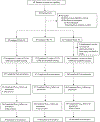Transcranial Magnetic Stimulation Promotes Gait Training in Parkinson Disease
- PMID: 32827221
- PMCID: PMC8470277
- DOI: 10.1002/ana.25881
Transcranial Magnetic Stimulation Promotes Gait Training in Parkinson Disease
Abstract
Objective: To determine whether priming with 1 or 25Hz repetitive transcranial magnetic stimulation (rTMS) will enhance the benefits from treadmill training up to 3 months postintervention in people with Parkinson disease (PD), and to evaluate the underlying changes in cortical excitability.
Methods: This randomized double-blind, placebo-controlled trial was conducted between October 2016 and December 2018. Fifty-one participants with PD were randomized to receive 12 sessions of rTMS (25Hz, 1Hz, or sham) followed by treadmill training. All participants were assessed at baseline and 1 day, 1 month, and 3 months postintervention. Primary outcome was fastest walking speed, and secondary outcomes were timed up-and-go test (TUG), dual-task TUG (DT-TUG), motor section of the Movement Disorder Society-Unified Parkinson's Disease Rating Scale (MDS-UPDRS-III), and electrophysiological evaluation of cortical excitability by TMS.
Results: The 1 and 25Hz rTMS groups produced a greater improvement in fastest walking speed at 1 day and 3 months postintervention than the sham group. Only the 1 and 25Hz rTMS groups sustained the improvements in TUG, and had a significant improvement in DT-TUG and MDS-UPDRS-III for up to 3 months. Behavioral improvements correlated with increased cortical silent period and short-interval intracortical inhibition in both groups receiving real rTMS.
Interpretation: Priming with 1 and 25Hz rTMS can augment the benefits of treadmill training and lead to long-term motor improvement up to 3 months postintervention. The motor improvement at follow-up was associated with a normalization of cortical excitability, which in turn suggests an alteration of the homeostatic plasticity range. Rebalancing cortical excitability by rTMS appears critical for plasticity induction. ANN NEUROL 2020;88:933-945.
© 2020 American Neurological Association.
Conflict of interest statement
Potential Conflicts of Interest
Nothing to report.
Figures



References
-
- O’Shea S, Morris ME, Iansek R. Dual task interference during gait in people with Parkinson disease: effects of motor versus cognitive secondary tasks. Phys Ther 2002;82:888–897. - PubMed
-
- Mehrholz J, Kugler J, Storch A, et al.Treadmill training for patients with Parkinson’s disease. Cochrane Database Syst Rev 2015;2015: CD007830. - PubMed
-
- Chung CL, Mak MK. Effect of repetitive transcranial magnetic stimulation on physical function and motor signs in Parkinson’s disease: a systematic review and meta-analysis. Brain Stimul 2016;9:475–487. - PubMed
-
- Cantello R, Tarletti R, Civardi C. Transcranial magnetic stimulation and Parkinson’s disease. Brain Res Brain Res Rev 2002;38:309–327. - PubMed
Publication types
MeSH terms
Grants and funding
LinkOut - more resources
Full Text Sources
Medical
Research Materials
Miscellaneous

